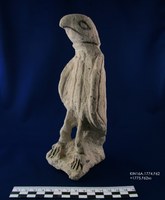Kınık Höyük Featured in Turkish News Release
 In December 2016, the Turkish Ministry of Culture and Tourism published an official online note highlighting the region's recent and significant archaeological finds. Mentioned in the article was Prof Lorenzo d'Alfonso's project at Kınık Höyük, where this summer they uncovered a hawk sculpture made of volcanic rock (ryholite) dating to the Achaemenid Period. Among the finds at other sites in Anatolia were a female figurine dating to the Neolithic period, a 3500 year old seal impression of the Hittite period, supposed to have belonged to the famous queen Puduhepa, and a marble statue of "Mother-Goddess Kibele."
In December 2016, the Turkish Ministry of Culture and Tourism published an official online note highlighting the region's recent and significant archaeological finds. Mentioned in the article was Prof Lorenzo d'Alfonso's project at Kınık Höyük, where this summer they uncovered a hawk sculpture made of volcanic rock (ryholite) dating to the Achaemenid Period. Among the finds at other sites in Anatolia were a female figurine dating to the Neolithic period, a 3500 year old seal impression of the Hittite period, supposed to have belonged to the famous queen Puduhepa, and a marble statue of "Mother-Goddess Kibele."
Read the full Turkish note here and a translation below:
T.C. CULTURE AND TOURISM MINISTRY
News Archive 2016
December 2016
EVERY YEAR THOUSANDS OF FINDS EMERGE TO THE LIGHT OF DAY FROM THE EARTH OF ANATOLIA
Anatolia, which has hosted many civilizations throughout history, is rich in historical heritage, and this is brought to light through archaeological excavations. In 554 archaeological excavations and researches carried out in Turkey in the last 11 months, 2,288 significant finds were excavated from underground.
Data collected last November report that 554 archaeological activities authorized by the Council of Ministers were carried out in different regions of Turkey, showing that artifacts of different genres such as coins, terracotta pots, stone objects and sculptures have been recovered.
This historical heritage lying in the Anatolian soil is restored to the cultivated world through excavation, restoration and survey research made by both domestic and foreign researchers.
A "Unique" Female Sculpture was found
At Çatalhöyük, in the province of Konya, at the excavations directed by Prof. Dr. Ian Hodder, a female figurine dating to the Neolithic period (8,000 to 5,500 BCE) appears as one of the most important artifacts ever uncovered at that site. This statue is described as "unique" because of the high quality craftsmanship and the extraordinary state of preservation; all parts of the body were there.
A hawk sculpture made of volcanic rock (rhyolite) dating to the Achaemenid Period found in the excavations carried out under the direction of Prof. Dr. Lorenzo D'Alfonso is another important artifact.
A 3,500 year old Seal Impression was found
In this year's excavations, a seal impression of about 3500 years ago was found, belonging to the Hittite period. The artifact came to light during the continuation of the excavations at Tatarli Hoyuk, in the province of Adana, under the direction of Dr. Serdar Girginer, which is suggested to have belonged to the famous Hittite queen Puduhepa, at the turn of the 13th century BC.
No less important is the discovery at the Ordu Kurul Kalesi of a marble statue of Mother-Goddess Kibele, which is estimated to be 2,100 years old. Found in excavations continued under the direction of Dr. Süleyman Yücel Şenyurt, chair of the Archeology Department at the Faculty of Humanities, Gazi University, The sculpture weighs approximately 200 kilograms.
Every year thousands of artifacts are made available to the public thanks to the work directed by many local and foreign academics, acting in accordance with the permit of the Ministry, and the artifacts of this list, are being prepared for publication after their classification in the museums.
(Source AA)
(19.12.2016)